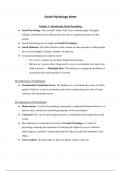Social Psychology Notes
Chapter 1: Introducing Social Psychology
● Social Psychology: The scientific study of the way in which people’s thoughts,
feelings, and behaviors are influenced by the real or imagined presence of other
people.
● Social Psychology has its origins in Gestalt Psychology.
● Social Influence: The effect that the words, actions or mere presence of other people
have on our thoughts, feelings, attitudes, or behavior.
● Is social psychology just common sense?
○ Yes, you’re a human so you know things about humans
○ But also no: you are often wrong and it’s easy to overestimate how much you
think you know → Hindsight bias: The tendency to exaggerate prediction of
an outcome after knowing that it occurred
The Importance of Explanation
● Fundamental Attribution Error: The tendency to overestimate the extent to which
people’s behavior is due to personality traits and to underestimate the role of social
influence and situational factors.
The Importance of Interpretation
● Behaviorism: A school of psychology saying that to understand human behavior, we
need to only consider the reinforcing properties of the environment
● Construal: The way in which people perceive, comprehend, and interpret the social
world.
● The emphasis on construal has its roots in Gestalt Psychology: A school of
psychology stressing the importance of studying the subjective way in which an
object appears in people’s minds rather than the objective, physical attributes of the
object.
● Naive realism: The belief that we perceive things ‘as they really are’.
,The Need to Feel Good About Ourselves
● Self-Esteem: People’s evaluations of their own self-worth - that is, the extent to
which they view themselves as good, competent, and decent.
The Need to Be Accurate
● Social Cognition: How people think about themselves and the social world; more
specifically, how people select, interpret, remember and use social information to
make judgments and decisions.
● Evolutionary Psychology: Attempts to explain human behavior in terms of genetic
factors that have evolved over time according to the principles of natural selection.
, Chapter 2: Methodology
Describing Social Behavior
● Observational Method: The technique whereby a researcher observes people and
systematically records measurements or impressions of their behavior.
● One example of the observational method is Ethnography: The method by which
researchers attempt to understand a group or culture by observing it from the inside,
without imposing any preconceived notions they might have.
● How do we know how accurate the observer is? It is important to establish
Interjudge Reliability: The level of agreement between two or more people who
independently observe and code a set of data; by showing that two or more judges
independently come up with the same observations, researchers ensure that the
observations are not the subjective, distorted impressions of an individual.
Chapter 3: Social Cognition
● Social Cognition: How people think about themselves and the social world; more
specifically, how people select, interpret, remember and use social information to
make judgments and decisions.
Low Effort Thinking
● Automatic Thinking: Thinking that is nonconscious, unintentional, involuntary, and
effortless.
● Schemas: Mental structures people use to organize their knowledge about the social
world around themes or subjects and that influence the information people notice,
think about, and remember.
, ○ Limitations: they can be self-fulfilling prophecies → when applied to
members of a social group, schemas often turn into stereotypes
● Accessibility: The extent to which schemas and concepts are at the forefront of
people’s minds and are therefore likely to be used when making judgments about the
social world.
● Priming: The process by which recent experiences increase the accessibility of a
schema, trait, or concept.
● Self-Fulfilling Prophecy: The case wherein people have an expectation about what
another person is like, which influences how they act toward that person, which
causes that person to behave consistently with people’s original expectations, making
the expectations come true.
○ Study by Rosenthal & Jacobson → found that a teacher who expects certain
students to do well may actually cause those students to do better (by paying
more attention to them, encouraging them more, etc)
Types of Automatic Thinking
● Schema’s are shortcuts people use, but we don’t have a ready made schema for every
judgment or decision → sometimes there are too many schemas available
○ So what do we do? → We use heuristics (mental shortcuts) that are efficient
because they are quick and usually lead to good decisions.
● Judgmental Heuristics: Mental shortcuts people use to make judgments quickly and
efficiently.
● Availability Heuristic: A mental rule of thumb whereby people base a judgment on
the ease with which they can bring something to mind.
○ Limitation: sometimes what is easiest to remember is not typical of the overall
picture, leading to faulty conclusions.
● Representativeness Heuristic: A mental shortcut whereby people classify something
according to how similar it is to a typical case.
○ Limitation: you may leave out relevant pieces of information, such as the base
rate information.
● Base Rate Information: Information about the frequency of members of different
categories in the population.




